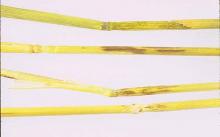Cause The soilborne fungus, Cephalosporium gramineum (sexual: Hymenula cerealis), overwinters in association with infected crop residue. Plants are infected through wounds in the root system caused by cultivation (including fertilizer application), frost heaving, freeze damage without heaving, or soil insects. Because frost heaving aggravates disease development, the disease is worse on wet, poorly drained soils. Recent WSU research indicates that seed transmission may occur at low levels. Repeated crops of susceptible cereals and grasses are associated with more severe disease. Early seeding dates and factors that promote rapid plant growth in the fall favor disease development by creating plants more susceptible to winter injury. Cool (40°F to 50°F) and wet conditions during the fall favor disease. Soil pH less than 6.0 favors this pathogen.
Symptoms Stripes appear in leaves at any growth stage. Seedlings may show a mosaic-like yellowing in early spring; leaves die before stripes develop. Two to three yellowish stripes that extend down to the leaf sheath, becoming prominently yellow and brown on maturing leaves. Because this fungus attacks the vascular system, a diagnostic feature is that vascular bundles are brown within the yellow stripes along affected leaf sheaths, and the joints are darkened inside. Leaves gradually yellow. Diseased plants may be stunted. Infected plants may mature early but heads either are empty or are filled with shriveled kernels. Plants can be stunted and form white-heads due to stems dying prematurely. Symptoms can be confused for strip rust.
Cultural control
- Use a 3-year rotation that includes only one susceptible crop or grassy weed. Winter wheat and barley are susceptible. Spring grains are acceptable rotation crops because they usually escape infection. Legumes and corn are nonhosts.
- Limit the size of the wheat plant in winter by planting late and limiting preplant nitrogen.
- Reduce inoculum in soil by controlling susceptible grass weeds such as Poa, Bromus, and Dactylis species.
- Plant tolerant winter wheat varieties (no resistant ones are available). Moderately Susceptible -'Coda', 'Eltan', 'Hill 81', 'Hiller', 'Hyak', 'Lambert', 'Lewjain', 'Madsen', 'Moro', 'Rely', 'Rod', 'Rohde', 'Sprague', 'Temple', and 'Weatherford'. Susceptible-'Gene', 'Malcolm', 'MacVicar', and 'Stephens'.
- Variety mixtures can be helpful for sites with a Cephalosporium problem. Current research at OSU recommends Coda/Rohde or Madsen/Rod mixtures.
- Removing infested straw reduces disease severity but is inconsistent with conserving soil and water. Burning or baling straw and inversion tillage with a moldboard plow are effective but not recommended.
Reference Murray, T.D. 1987. Cephalosporium Stripe Disease of Cereals. EB1434., Pullman, WA. Washington State University


